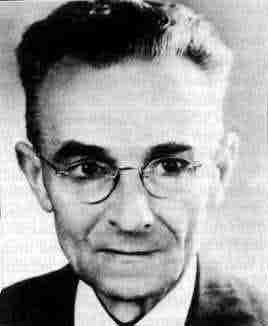


 تاريخ الرياضيات
تاريخ الرياضيات
 الرياضيات في الحضارات المختلفة
الرياضيات في الحضارات المختلفة 
 الرياضيات المتقطعة
الرياضيات المتقطعة
 الجبر
الجبر
 الهندسة
الهندسة 
 المعادلات التفاضلية و التكاملية
المعادلات التفاضلية و التكاملية 
 التحليل
التحليل
 علماء الرياضيات
علماء الرياضيات |
Read More
Date: 22-5-2017
Date: 22-5-2017
Date: 27-5-2017
|
Died: 20 April 1957 in Annecy, France

Konrad Knopp's father was Paul Knopp and his mother was Helene Ostertun. Paul Knopp (1845-1904) was a businessman and manufacturer from Neustettin (the town is now in northwest Poland and is named Szczecinek). His wife Helene (1857-1923) was the daughter of Otto Ostertun who was a head forester. Konrad's school education was in Berlin, then he spent one semester at the University of Lausanne in 1901. Following this he went to the University of Berlin where he was taught by Schwarz, Frobenius, Schottky, Landau and Schur, receiving a qualification to teach in 1906 and a doctorate in 1907. His doctoral studies were supervised by Schottky and Frobenius, and he was awarded the degree for his thesis Grenzwerte von Reihen bei der Annäherung an die Konvergenzgrenze.
Knopp left Germany in the spring of 1908 and travelled to Japan where he taught in Nagasaki in western Kyushu, at the Handelshochschule during 1908-09. He then travelled in India and China. In 1910 he returned to Germany and married the painter Gertrud Kressner (1879-1974), the daughter of Colonel Karl Kressner and Hedwig Rebling; they had one son and one daughter. Konrad and Gertrud Knopp then moved to Tsingtao, eastern Shantung province, China where he taught at the German-Chinese academy during 1910-11. Germany had occupied Tsingtao in 1897, modern port facilities had been installed and a modern European-style city had been created. In 1911 Knopp and his wife returned from Tsingtao to Germany and he taught at the Military Technical Academy and the Military Academy while working on his habilitation thesis which he submitted to Berlin University. Knopp became an officer in the army during World War I, being wounded in action near the beginning of the war.
After being wounded he was discharged from the army and by the autumn of 1914 he was teaching at Berlin University. In the following year he was appointed as an extraordinary professor at Königsberg, becoming an ordinary professor there in 1919. Examples of some papers he published during this period are:Bemerkungen zur Struktur einer linearen perfekten nirgends dichten Punktmenge (1916); Ein einfaches Verfahren zur Bildüng stetiger nirgends differenzierbarer Funktionen (1918); Mittelwertbildung und Reihentransformation (1920); and Über das Eulersche Summierungsverfahren (1923). He was appointed to a chair of mathematics at Tübingen University in 1926 and he remained there until he retired in 1950. Examples of publications during this time are Zur Theorie der Limitlerungsverfahren (1930); and Über die maximalen Abstände und Verhältnisse verschiedener Mittelwerte (1935).
Knopp worked on generalised limits and wrote excellent books on complex functions. Theorie und Anwendung der Unendlichen Reihen was published in 1922. Elemente der Funktionentheorie was published in 1936 with an English translation appearing in 1953. The chapters of the book are:
Chapter I: Complex numbers and their geometric representation.
Chapter II: Linear functions.
Chapter III: Sets, sequences and power series.
Chapter IV: Analytic functions and conformal mapping.
Chapter V: Elementary functions.
He produced the sixth edition of Hans von Mangoldt's famous Höhere Mathematik: eine Einführung für Studierende und zum Selbststudium (Higher mathematics: an introduction for students and for self-study). The book continued to appear as a jointly authored text by von Mangoldt and Knopp, and the three volumes which were reprinted in 1990 were the seventeenth, sixteenth and fifteenth editions of these volumes respectively. Volume 1 covers numbers, functions, limits, analytic geometry, algebra, set theory; volume 2 covers differential calculus, infinite series, elements of differential geometry and of function theory; and volume 3 covers integral calculus and its applications, function theory, differential equations. Friedrich Lösch added a fourth volume in 1980 to cover more modern material: set theory, Lebesgue measure and integral, topological spaces, vector spaces, functional analysis, integral equations. The review of the 1990 reprint states:-
This famous and comprehensive introduction to analysis by von Mangoldt and Knopp has been popular for generations of German-speaking students, in mathematics, physics and other natural sciences, and engineering.
He was the co-founder of Mathematische Zeitschrift in 1918, being the editor from 1934 to 1952.
After he retired Knopp continued to publish interesting papers such as Zwei Abelsche Sätze (1952) in which he proved abelian theorems for Laplace and Abel transforms which are closely related to the well-known Tauberian theorems of Karamata. He was invited to lecture in March 1952 at a meeting held in conjunction with the first meeting of the International Mathematical Union. He chose to give the expository lecture Folgenräume und Limitierungsverfahren. Ein Bericht über Tübinger Ergebnisse.
Articles:



|
|
|
|
علامات بسيطة في جسدك قد تنذر بمرض "قاتل"
|
|
|
|
|
|
|
أول صور ثلاثية الأبعاد للغدة الزعترية البشرية
|
|
|
|
|
|
|
العتبة الحسينية تطلق فعاليات المخيم القرآني الثالث في جامعة البصرة
|
|
|